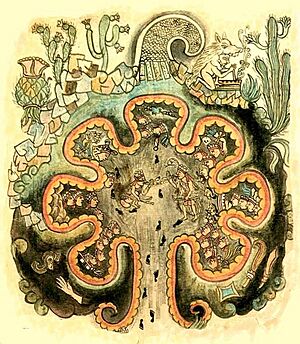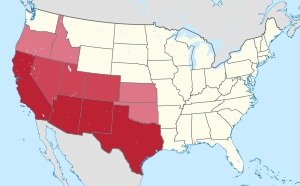Aztlán facts for kids
Aztlán is believed to be the original home of the Aztec people. The word Aztec comes from Astekah, which means "people from Aztlan" in the Nahuatl language. Aztlan is mentioned in old historical writings from the time when Europeans first arrived in Mexico. These writings describe different groups of people who left Aztlan to travel to central Mexico. The Mexica people, who later built the famous city of Mexico-Tenochtitlan, are always mentioned in these stories.
Historians have wondered where Aztlan might have been. Some think it was in northwestern Mexico or the Southwestern United States. However, it's also possible that Aztlan was a mythical place, not a real one.
Contents
The Legend of Aztlán
Old stories from the Nahuatl people say that seven tribes lived in a place called Chicomoztoc, which means "the place of the seven caves." Each cave was home to a different Nahua group: the Xochimilca, Tlahuica, Acolhua, Tlaxcalteca, Tepaneca, Chalca, and Mexica. These tribes are all called "Nahualteca" (Nahua people) because they spoke similar languages. After leaving the caves, they settled "near" Aztlán.
The descriptions of Aztlán in different legends can be confusing. Some stories say Aztlán was a beautiful paradise. But the Codex Aubin says the Aztecs were ruled by harsh leaders called the Azteca Chicomoztoca. Because of this, the Aztecs, led by their priest, decided to leave. As they traveled, their god Huitzilopochtli told them not to call themselves Azteca anymore. He said they should be known as Mexica.
Some people believe the journey south began around May 24, 1064 CE. Each of the seven groups is said to have founded a major city-state in Central Mexico. One old book, the Anales de Tlatelolco, mentions a specific date for leaving Aztlan: January 4, 1065.
A story tells how the people found their new home: One day, a man heard a bird calling, "Go now, go now." When he told his chief, the chief was happy. He knew his people needed a new land and had been waiting for a sign. So, the people gathered and started a long journey. They followed an idol of Huitzilopochtli carried by their priests. As they traveled, Huitzilopochtli spoke through the priests. He told them they would become a great empire. He said they should travel until they reached a large lake. There, they would look for another sign: an eagle on a cactus.
The journey took 200 years. The people stayed for a while in the Toltec capital of Tollan. Some stayed there, while others moved on. Sometimes, Huitzilopochtli would turn into a white eagle to encourage them. They kept traveling until they reached Lake Texcoco. There, they saw a great eagle sitting on a cactus, holding a snake. This was the sign! There, they built Tenochtitlán, which became the capital of the Aztec empire.
Where Could Aztlán Be?

Even though we now know the Mexica people came to their final city from Tula (and other places), people in the past tried hard to find the "mythical" location of Aztlán. Friar Diego Durán, who wrote about Aztec history, said that the Aztec emperor Moctezuma I sent wise men and warriors on a trip to find Aztlán. According to Durán, they found a place that matched the descriptions of Aztlán. However, Durán wrote his accounts shortly after the Spanish conquered Tenochtitlan, before accurate maps of the Americas existed. So, he couldn't give an exact location.
In the 1960s, Mexican thinkers began to wonder if Mexcaltitán de Uribe could be the legendary city of Aztlán. This island in Nayarit was first suggested by historian Alfredo Chavero in the late 1800s. Other historians later explored this idea, and it is still discussed today.
What Does "Aztlán" Mean?
The exact meaning of the name Aztlan is not certain. One idea is that it means "place of Herons" or "place of egrets." However, this doesn't quite fit the rules of the Nahuatl language. Other ideas include "place of whiteness" or "at the place near tools."
Aztlán and the Chicano Movement
The idea of Aztlán as the original home of Mexican civilization has become an important symbol for different Mexican nationalist and indigenous groups.
In 1969, the poet Alurista introduced the idea of Aztlán at a meeting called the National Chicano Youth Liberation Conference in Denver, Colorado. He read a poem that became known as "El Plan Espiritual de Aztlan." For some Chicanos, Aztlán refers to the lands in the United States that used to belong to Mexico. These lands were taken by the United States after the Mexican–American War (1846–1848). Aztlán became a symbol for activists who believe they have a historical right to this land. Some members of the Chicano movement even suggest creating a new nation called the República del Norte in these areas.
Aztlán is also the name of a journal about Chicano studies published by the UCLA Chicano Studies Research Center.
Groups Using the Idea of Aztlán
- Brown Berets
- MEChA (Movimiento Estudiantil Chicano de Aztlán, meaning "Chicano Student Movement of Aztlán")
- Plan Espiritual de Aztlán
- Raza Unida Party
- Freedom Road Socialist Organization, which supports the right for the Chicano people in Aztlan to decide their own future, even if it means forming their own country.
Aztlán in Popular Culture
In Books
"Aztlán" has been used as the name for fictional future states in the southwestern United States or Mexico in many books. Examples include Heart of Aztlán (1976) by Rudolfo Anaya, Warday (1984) by Whitley Strieber and James Kunetka, and World War Z (2006) by Max Brooks. In the role-playing game Shadowrun, the Mexican government is taken over by a company called Aztechnology. In Gary Jennings' novel Aztec (1980), the main character lives in Aztlán for a while.
"Strange Rumblings in Aztlan" is an article by Hunter S. Thompson. It appeared in Rolling Stone magazine in 1971. The article is about the death of civil rights activist Ruben Salazar in East Los Angeles during a protest against the Vietnam War.
In Video Games
In the computer game Hearts of Iron IV, there's an expansion called "Man the Guns." It allows Mexico to choose a goal called "Redeem Aztlan." If Mexico achieves this, it gains control over seven US states that used to be part of Mexico. If the United States is already under Mexico's control, Mexico will fully take them over.
See also
 In Spanish: Aztlán para niños
In Spanish: Aztlán para niños



